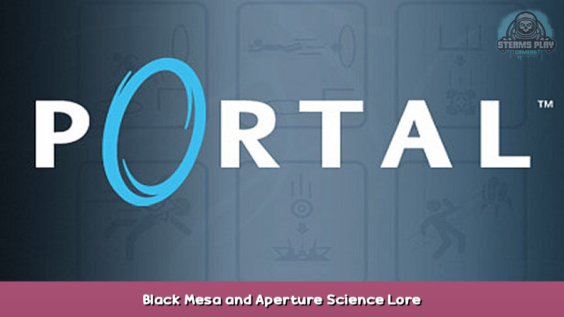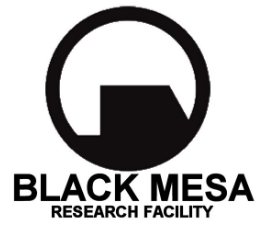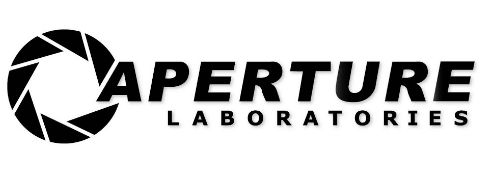
This is the lore about both Black Mesa and Aperture Science
Black Mesa
The Black Mesa facility was apparently built over several decommissioned ICBM launching and testing silo complexes probably constructed during the 1950s, which was converted into a vast civilian institute for the research of almost every conceivable scientific discipline. Several Half-Life texture files’ names contain the word “fifties”, suggesting the facility is as old as from the 1950s. Some areas are also described by characters such as Rosenberg as “old” or “abandoned”; several areas of the complex are badly run-down despite the obvious fact that they are still in use. However the surface areas of Black Mesa feature more modern construction.
Black Mesa undertakes its various scientific researches in the facility, which is a very high-security complex, as each employee is required to undergo a series of rigorous security checks to access most areas. Security guards, carrying firearms and trained for emergencies, are present in all of the facility. The complex is also equipped with retinal scanners and alarms, as well as heavy blast doors that may shut down in case of fire, explosion or other event. Black Mesa can be completely sealed from the outside.
The facility is self-sufficient, housing its own: ventilation, cold and hot water, central heating, sanitation, drainage, and power generation systems including a Hydro-Electric Dam and multiple types of electrical generators and reactors, some using nuclear technology. Chemical processing plants are also seen and as the facility is located within the desert water treatment plants are required to recycle waste water.
The complex is dominated by a number of underground laboratories, test areas (including an Anti-Mass Spectrometer), and administration offices, most of which contain very high-tech equipment, and even a rocket launch site.
The complex also features multi-story car parks (where only Black Mesa SUVs can be found), arsenals of nuclear and conventional weapons, and a local electric rail materials transport network, Sector E Materials Transport.
Black Mesa is also apparently kept supplied by a conventional freight rail linked to the outside, managed in the Freight Yard.
As employees are required to live in the complex itself, Black Mesa contains many personnel facilities, including laundromats, recreation and sports areas such as lounges, at least one basketball court, at least one swimming pool, a library, fast food outlets, food courts, cafeterias, and numerous vending machines.
The facility is well-populated by rest areas and dormitories for the employees of the facility. As Eli Vance reveals in Half-Life 2 that his wife and daughter lived in Black Mesa with him, it can be inferred that employees’ families reside in the dormitory complexes as well.
All main Sectors are linked together by the Black Mesa Transit System, the monorail network going through the whole facility.
Black Mesa is equipped with a public address system, the Black Mesa Announcement System, relaying audible messages and announcements across the facility with a male voice. It is also used in the Black Mesa Transit System to give general information about the facility and mention each stop, with a female voice.
The complex also has its own newspaper, The Mesa Times, which is sold within the Black Mesa Research Facility to inform the personnel about events within and outside of the facility.
Despite being located in the middle of a desert, the underground and indoor sectors of Black Mesa are “maintained at a pleasant 68° Fahrenheit (20° Celsius) at all times”, enabled by Black Mesa’s sprawling network of ventilation ducts.
In the underground laboratories, administration offices and dormitories, the main sections are always indicated in important intersections areas, and follow color codes consisting of lines running along the corridors to the related location. Several colors can be seen running along corridors, disappearing each time a related location is reached. This is seen for instance in Sector C and the Level 3 Dormitories.
Overall, Black Mesa is almost as large as a city and is completely self-sustainable in all fields.
In the event of an emergency, the “military” and “trained assassins”, referred to as “a dangerous and very efficient clean-up crew” are to enter the facility. This suggests that Black Mesa has experienced problems with escaped specimens in the past and that a possible intervention from the HECU and the Black Ops is a known fact among the personnel, although some employees consider it a rumor. Possibly to deal with potential escaped specimens, or perhaps being a leftover from the facility’s days as a military missile complex, Black Mesa contains many automated ceiling turrets, which, when activated, will emerge from armored cupolas and fire upon any moving object in their line of sight.
Aperture Science
1940s
Aperture Fixtures was founded in the late 1940s by Cave Johnson as a shower curtain manufacturer – the name “Aperture Fixtures” was chosen “to make the curtains appear more hygienic” – and by 1943 Cave’s company was routinely earning the annual shower curtain salesman award. Using his newly accumulated funds, Cave invested in real estate and purchased a vast, decommissioned salt mine in Michigan in January 1944. Aperture Science Innovators was incorporated in 1947, receiving the Best New Science Company Award that same year, granted by the Science and Business Institute of America. Its long rivalry with Black Mesa started at the same time: Aperture was #2 on the Top 100 Applied Science Companies ranking for 1949, starting a pattern that would never be broken.
1950s
The salt mine served as the foundation for the future Aperture Science facility, from 1952 onwards. Rather than delve into it and build downwards, Johnson elected for an unorthodox approach and began building from the floor up, starting at four kilometers of depth and moving upwards. Nine test shafts were designed, with asbestos enrichment spheres serving as self-contained testing environments. As Aperture was riding high, no expense was spared, with waiting rooms furnished with genuine wooden paneling, wrought iron fittings, with attendants catering to every whim of the test subjects shuttled to the Michigan facility with limousines. Johnson attracted the cream of the crop to Aperture, including astronauts, war heroes, and Olympic athletes, As a prestigious scientific organization at the time, test subjects waived their fees and they were instead donated to charitable organizations. Each subject’s background determined the kind of assignment they received and in which test shaft they’d perform the tests.
The first enrichment sphere in test shaft 09 was completed in 1953 and tests focused on the repulsion gel. Aperture’s peculiar approach to testing existed since the beginning, as the control group for the repulsion gel only received blue paint, leading to brutal injuries among the test subjects. The gel also contained untested elements and compounds, which did not agree with the skeleton system (violently so), and sumbersion in the gel could have catastrophic consequences for health. Johnson was also a wild card, routinely recording messages for test subjects that also violated scientific protocol.
Other tests performed in the fifties included genetic modification (combining human and praying mantis DNA), which were eventually postponed indefinitely and replaced with combat tests against an army of mantis men, reducing human water content from sixty to thirty and even twenty percent by exposure to jet engines, more genetic modification by using nanomachines to pump experimental genes and RNA molecules into test subject tumors (complimentary tumors were provided using machines disguised as folding chairs in the lobby; anything short of lead underpants resulted in irradiation), using lasers to turn test subject blood into gasoline, coffee dosed with fluorescent calcium to monitor neuronal activity (at the risk of vitrifying the frontal lobe of the subject), trace amounts of time travel, and more. The asbestos enrichment spheres turned out to be the least dangerous element of testing at Aperture Science.
Despite the horrific nature of Johnson’s experiments, Aperture remained popular. In 1956, the Eisenhower administration signed a contract with Aperture to manufacture shower curtains to all branches of the US Military, except the Navy. Aperture also landed numerous defense contracts with the Department of Defense, earning the runner up prizes for Contractor of Defense for 1952, 1953, and 1954, always coming up second behind Black Mesa. It has also earned the Spirit of Idaho award for 1955, awarded by the National Potato Board for promoting “potato science”.
The funding allowed Aperture to complete three enrichment spheres in test shaft 09 by 1958 and a repulsion gel pumping station. At its peak, over a thousand tests were performed per day, although it remained a hostile work place to both test subjects and employees. Cave once fired a disabled employee on the spot to save on making access ramps.
1960s
Eventually, the notorious nature of testing caught up with Aperture. The bottom section was sealed off on June 15, 1961, officially due to “cosmic ray spallation elements”, and many more test chambers were sealed and vitrified. However, the greatest blow to Aperture Science came with the 1968 Senate Hearings on missing astronauts, resulting in bankruptcy. Johnson also blamed industrial espionage by Black Mesa for his misfortune.
1970s
Johnson somehow managed to keep his company intact and the Michigan facility expanded further in the seventies, with new enrichment spheres installed and a new access level completed by 1971. The financial peril that Aperture landed itself in also resulted in large cutbacks, with the elegant wooden paneling, marble, and carpeting replaced by cheap plastic, linoleum, and imitation wood in the newly erected 70s offices. Tests focused on the Propulsion Gel, newly created by Aperture’s experimental units. Despite the hardship, Aperture completed its greatest achievement yet in 1971, building a complete dry dock 3975 m below the surface in its Michigan facility, constructing the infamous Borealis icebreaker that would represent the greatest achievement of Aperture’s portal technology. Its disappearance with parts of the drydock would become legendary among experts in the field.
Deprived of access to elite test subjects, Aperture started scraping the bottom of the social barrel to put people into the testing machine: $60 were offered to vagrants and homeless people in return for participation. The unethical enticement served to provide a steady supply of disposable test subjects and as a distraction from the mountain of legal paperwork they had to sign. Johnson’s messages reinforced the financial motivation, with barely concealed contempt added into the mix. Survivors were immediately removed from the facility, and constantly monitored in case they could soil the facility’s interior, provided with a compensation voucher. By 1976, victims of Johnson’s predatory practices could earn another $60 for volunteering to be vivisected, fitted with undisclosed “science stuff”, and then reassembled. Notably, tumors would be removed at no extra charge.
Aperture was well aware of the multitude of laws it was breaking and focused on maintaining secrecy. Employees were mandated to alert supervisors if they spotted a journalist or government official, including inspectors for Public Works, OSHA, and the Department of Energy, Government Accountability Office accountants, FEMA coordinators, Nuclear Regulatory Commission representatives, police officers (plainclothes and unfiromed), MSHA mine inspectors, and officers from the ATF, FBI, or US Marshals.
1980s
Testing using vulnerable people snatched up from the street wrapped up around 1978, with Aperture switching to a different approach in 1981: Automatization. Human supervisors were replaced with tireless androids, with the remainder of Aperture’s human staff instructed to participate in testing. Participation was mandatory, leading to a sharp increase in test subject quality, but an equally sharp drop off in terms of employee retention. Employees were expected to volunteer for testing, with only exceptions granted for those who had allergies to lunar rocks, starch, fulfilled their monthly quota, or had faith in their work performance. Ever-present corporate propaganda reminded employees that they were expendable and that androids could perform their work far better, all to nudge them towards volunteering for testing. The quality of Aperture robots was uneven: Exceptional processing power was married to zero safeguards, with employees instructed to deal with rogue AIs using paradoxes.
Aperture Science (Continued)
1980s (Continued)
By 1982, the company finalized work on the third and final type of gel, Conversion Gel. Created using ground-up Moon rocks purchased by Johnson at a price of seventy million dollars. Valued at $210 million in 2020 dollars, the purchase was made despite his accountants stating that the company couldn’t afford seven bucks worth of rocks. Johnson did what Johnson did best, and was exposed to ground-up moon rocks in the process. Fatally ill, Johnson noted the new gel was an excellent portal conductor and tested whether passing through portals could leech the poison out of his bloodstream. Never particularly coherent in the first place, Johnson’s condition suffered due to constant, crippling pain and reliance on painkillers. Before his death that same year, Johnson ordered his engineers to perfect a process of brain mapping and transferring his consciousness into a computer, indirectly starting the development of GLaDOS. Remorseful that he didn’t order such research in the fifties and aware of his impending death, he instructed Aperture staff to use Caroline in his stead and have her run Aperture Science.
Hell-bent on achieving his goals, he instructed Aperture scientists to make her take the company over and be transferred to a computer. Caroline did, in fact, take over management of the company after Johnson died of moon rock poisoning, continuing its scientific mission. The old mine shafts and enrichment spheres were sealed off using massive transition seals and used as foundation for a completely new facility, the Enrichment Center, constructed on top of them. Gel research was abandoned in favor of a focus on portals and development of proprietary technologies to make Aperture independent of third party technologies. One such example is the Aperture Image Format created in 1985, and maintained by Doug Rattmann.
Upon realizing that Black Mesa began work on similar teleportation technology, Aperture Science pursued the development of GLaDOS in 1986, intended to supercharge their portal program.
1990s
After a decade spent bringing the Disk Operating System parts of GLaDOS to a state of more or less basic functionality, work begins on the Genetic Lifeform component in 1996. During that time, the Aperture Science Red Phone plan is implemented in case GLaDOS appears to become sentient and godlike, requiring an employee to sit by a red phone on a desk in the GLaDOS chamber’s entrance hall.
In 1997, GLaDOS’ version is 3.11.
In 1998, Aperture releases other testing elements, such as the Excursion Funnel, a tractor beam-like funnel made of liquid asbestos, the Thermal Discouragement Beam, a laser to destroy Sentry Guns and activate buttons, the Aerial Faith Plate, a catapult plate flinging into the air Test Subjects or any other object upon contact, and the Pneumatic Diversity Vent, a variant of the Vital Apparatus Vent used for distributing objects to Test Chambers.
In 200-, the untested AI of GLaDOS is activated for the first time as one of the planned activities on Aperture’s first annual bring-your-daughter-to-work day. Upon being activated, she almost instantly becomes self-aware, takes control of the facility, locks everyone inside, floods the Enrichment Center with deadly neurotoxin, but is partially halted when she is quickly fitted with a Morality Core. She then begins a permanent cycle of testing, aimed at beating Black Mesa in the race to develop functioning portal technology. However a few days later, on May 16, the Black Mesa Incident occurs at the Black Mesa Research Facility, allowing aliens to teleport from Xen to Earth, eventually leading to the Combine invasion, stopping GLaDOS’ race against Black Mesa.
This is all for Portal Black Mesa and Aperture Science Lore hope you enjoy the post. If you believe we forget or we should update the post please let us know via comment, we will try our best to fix how fast is possible! Have a great day!
- Check All Portal Posts List



Leave a Reply